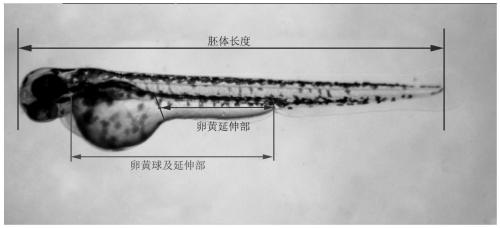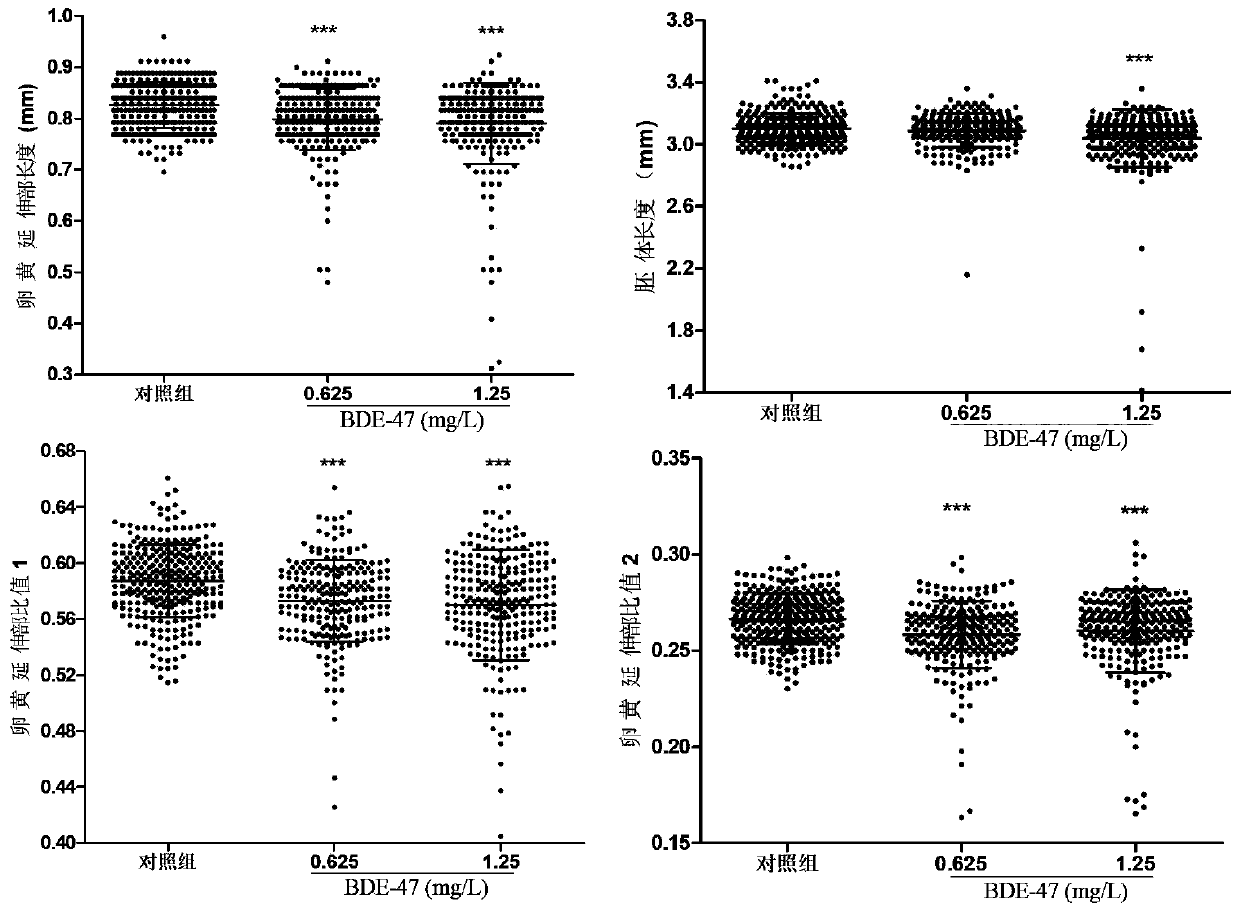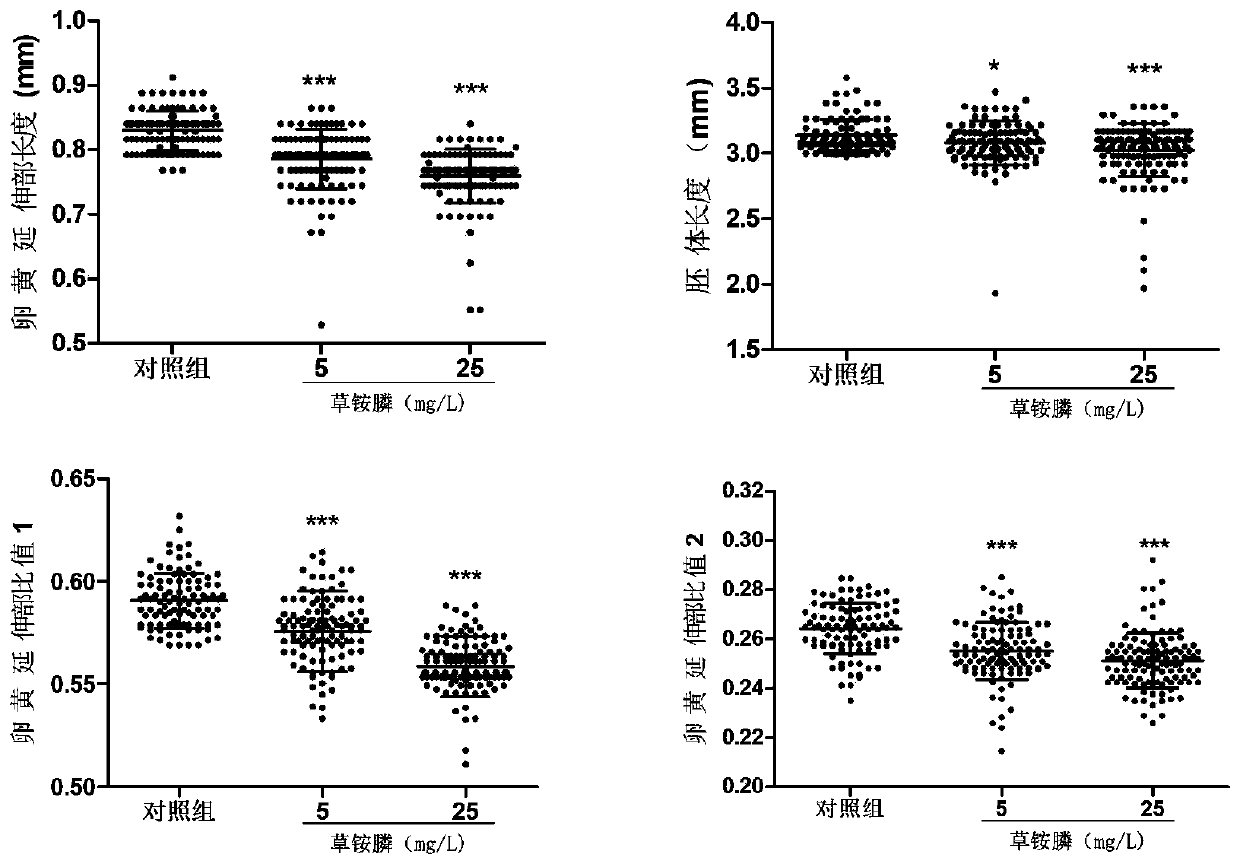Method for evaluating developmental toxicity of environmental pollutants by utilizing lengths of egg yolk extension parts of Danio rerio
A technology for environmental pollutants and extensions, applied in the field of environmental detection technology and toxicity research, can solve the problems of unpredictable developmental toxicity risks, high pollutant exposure doses, and large dose differences.
- Summary
- Abstract
- Description
- Claims
- Application Information
AI Technical Summary
Problems solved by technology
Method used
Image
Examples
preparation example Construction
[0035] The method for preparing fertilized eggs preferably includes the following steps: separately placing male and female zebrafish at the age of 5 to 6 months in a culture tank with a constant temperature circulating water system for feeding, wherein the culture water in the culture tank is aerated and heated The water temperature in the culture tank is 27.5-28.5°C, the dissolved oxygen in the water is greater than 6.0mg / L, the pH of the water body is 7.0-8.0, and the light cycle of 14h light / dark 10h is maintained; 1 day before spawning, according to male and female The zebrafish was moved to the spawning box at a ratio of 1:1; the spawning box was placed in an artificial climate box at 27.5-28.5°C overnight, and the light was turned on at 6:30-7:30 the next morning, so that the female and male The fish mate naturally, and after about 15 minutes, the fertilized eggs are collected, placed in a plate, and the feces and impurities are cleaned with a rubber dropper. Select emb...
Embodiment 1
[0052] A method for evaluating the developmental toxicity of environmental pollutants by using the length of zebrafish yolk extension, comprising the following steps:
[0053] Breeding of zebrafish: The zebrafish is raised in a culture tank with a constant temperature circulating water system, wherein the culture water in the culture tank is tap water heated by aeration, and the water temperature in the culture tank is 28±0.5°C. The dissolved oxygen is greater than 6.0mg / L, the pH of the water is 7.0-8.0, and the photoperiod of 14h light / 10h dark is maintained. Feed freshly hatched Artemia every day from 7:00 to 9:00, 14:00 to 15:00 and 19:00 to 20:00.
[0054] Obtaining fertilized eggs: Separate male and female zebrafish at the age of 5 to 6 months and raise them in a culture tank with a constant temperature circulating water system, wherein the culture water in the culture tank is aerated and heated tap water. The water temperature is 28±0.5°C, the dissolved oxygen in the w...
Embodiment 2
[0070] Evaluation of the developmental toxicity of 2,2',4,4'-tetrabromodiphenyl ether using the length of yolk extension in zebrafish embryos
[0071] Environmental pollutants: organic pollutant 2,2’,4,4’-tetrabromodiphenyl ether (BDE-47).
[0072] Preparation method: Dissolve 25mg BDE-47 in 5mL dimethyl sulfoxide (DMSO), add 495mL embryo culture solution to make BDE-47 mother solution (50mg / L); take 100mL BDE-47 mother solution, add 900mL embryo culture solution , made into BDE-47 stock solution (5mg / L); BDE-47 stock solution was diluted with embryo culture medium to a concentration of 1.25 and 0.625 mg / L.
[0073]The developmental toxicity of BDE-47 was tested by the method of Example 1. Embryos in the experimental group were cultured in 0.625 or 1.25 mg / LBDE-47 solution, and a control group was established, and the embryos in the control group were cultured in the control solution. In the blank control group of the present invention, it is preferable to add culture soluti...
PUM
| Property | Measurement | Unit |
|---|---|---|
| concentration | aaaaa | aaaaa |
Abstract
Description
Claims
Application Information
 Login to View More
Login to View More - R&D
- Intellectual Property
- Life Sciences
- Materials
- Tech Scout
- Unparalleled Data Quality
- Higher Quality Content
- 60% Fewer Hallucinations
Browse by: Latest US Patents, China's latest patents, Technical Efficacy Thesaurus, Application Domain, Technology Topic, Popular Technical Reports.
© 2025 PatSnap. All rights reserved.Legal|Privacy policy|Modern Slavery Act Transparency Statement|Sitemap|About US| Contact US: help@patsnap.com



